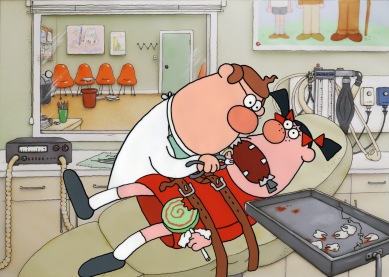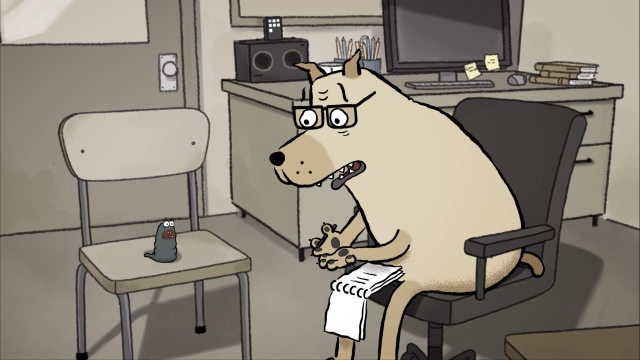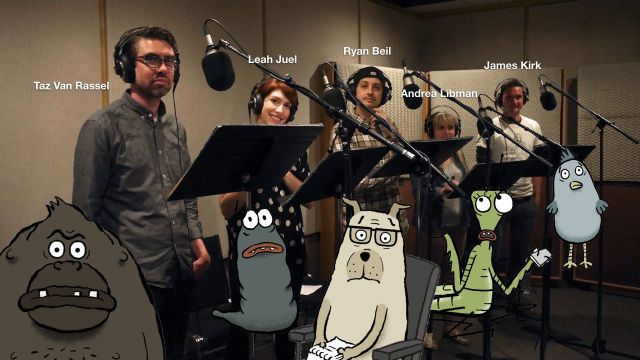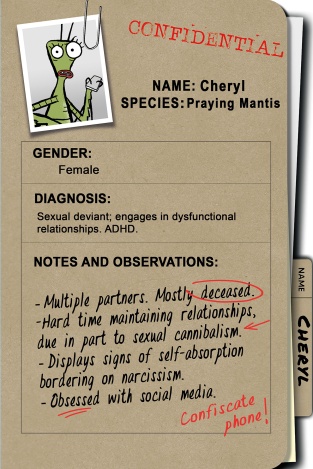By Anita Malhotra
Vancouver-based animators, directors and writers Alison Snowden and David Fine received some very good news recently – an Oscar nomination for their most recent animated short film, Animal Behaviour.
The film, produced and distributed by the National Film Board of Canada, is a humorous look at what happens when a new animal joins a canine-led therapy session for five animals (a leech, praying mantis, pig, cat and bird), who are struggling with their natural instincts.

Still from “Animal Behaviour” by Alison Snowden and David Fine (photo courtesy of the National Film Board of Canada)
Snowden and Fine, a husband-and-wife team, have been working together since they met in the early ‘80s at England’s National Film and Television School.
Their films include the Oscar-winning short animation Bob’s Birthday (1994) and the Oscar-nominated shorts Second Class Mail and George and Rosemary.

Alison Snowden and David Fine at the National Film Board studio in Vancouver (photo by Katja De Bock)
They also created the animated TV series Bob and Margaret (1998-2001), for which they served as executive producers, writers, and in Snowden’s case, voice actor. Other TV series they created were Ricky Sprocket: Showbiz Boy and Shaun the Sheep.
Anita Malhotra spoke to Snowden and Fine, who were at their Vancouver home, by phone on Feb. 8, 2019, two weeks before Oscar night on Feb. 24, 2019.
AM: Congratulations on your Oscar nomination and the other awards you’ve won so far for Animal Behaviour. I understand you’ve just come back from Los Angeles. What were you doing there?
AS: They have a luncheon for the Oscar nominees. It’s a more relaxed atmosphere and they take a big group photo of this year’s nominees, and it was really lovely.

David Fine and Alison Snowden with their daughter, Lily Snowden-Fine, at the Oscar Nominees Luncheon on Feb. 5, 2019 at the Beverly Hilton (photo by Michael Fukushima, courtesy of David Fine)
DF: It’s kind of a celebration of the nomination, whereas the Oscars, there are going to be winners and losers. So it’s quite nice because the atmosphere is, “We’re all winners here because we’re all nominated.”
AM: You won an Oscar in 1994 for your animated short Bob’s Birthday. How does it feel to be going to the Oscars again with a new film?

David Fine and Alison Snowden at the 1994 Academy Awards, where they won an Oscar for their short animated film “Bob’s Birthday” (photo by Clare Kitson, courtesy of David Fine)
DF: Awesome.
AS: Very exciting. It’s not totally new, of course. Actually, we’ve been a few times because we were nominated prior to Bob’s Birthday.
DF: It really doesn’t get old, being nominated for an Oscar. It’s a great honour.

Still image from Snowden and Fine’s Oscar-winning film “Bob’s Birthday” (© Snowden Fine Animation, Channel 4 and the National Film Board of Canada)
AM: What was the impetus to make a short film after so many years of working in animated television series?
AS: When you make a series, the wonderful thing is you’re making lots of stories, lots of episodes, working with a crew that all bring their own talents to it, and it’s much more sociable and exciting.
But in our position, we’re not animating or working that closely with the characters. We’re just directing in a general sense. So we missed that.

Still image from Snowden and Fine’s animated TV series “Bob and Margaret,” which ran from 1998-2001 (courtesy of Snowden Fine Animation)
Also, with a series you have a very rigid schedule – you have to pump out all the stories. But if you’re just concentrating on one short – it’s a bit like making a feature film –it’s one story that will carry it.
You really have the time to try and perfect it and make it work exactly how you want it to.
AM: Who first came up with the concept for Animal Behaviour?
DF: We both bounce ideas off each other. Alison had this idea a long time ago for a story that she called “I Love You,” which was about a woman in therapy trying to learn to love herself.

Dr. Clement tries to help Lorraine the leech with her issues in Snowden and Fine’s “Animal Behaviour” (still courtesy of the National Film Board of Canada)
AS: I went to a confidence-building class at my local community centre years ago, and you always find all the different characters there. And one thing they did was make you look into a mirror and tell yourself, “I love you.”
Of course everyone was cringing – it’s really hard. So I just thought that was quite funny. I’ve always struggled with confidence, so I thought I’m going to make a short film about this. But I ended up not doing that.

Michael Fukushima, producer of “Animal Behaviour” and Executive Producer of the National Film Board’s Animation Studio (photo courtesy of the National Film Board of Canada)
DF: Then we had a series idea for an animated sketch show that involved animals going for cosmetic surgery to try and change attributes that they felt didn’t work for them.
And so it grew out of animals examining themselves and Alison’s therapy thing.
And we just thought, “What if we had a group therapy session where animals had to question what comes naturally to them the way humans do?”
AM: How long did it take you to make the film?
AS: From start to finish it was a long time because there were delays. In terms of actually animating it, getting talent and making it, it was about two and a half years. But before that we worked on the script and got it through the development stage, which took a while.

Cheryl the praying mantis showing signs of ADHD during her group therapy session in Alison Snowden and David Fine’s “Animal Behaviour” (still courtesy of the National Film Board of Canada)
AM: How did you choose the animal characters that you have in the film? I believe you started with a few more and went through different iterations.
AS: Yes, we did. Because once we had the concept, we were trying to think what animals would fit best in that room. We tried a chameleon at the beginning –someone that’s always trying to fit in but in that way is sort of invisible.
We worked with him for a while on the storyboard, but somehow his story and his physical presence didn’t work as well as we would have liked.
Also, at the beginning there were too many characters with too many stories. So we replaced a couple of animals with other animals with more physical problems like the pig. Because he doesn’t really tell his story – he just acts on his issue. So that gave us more physical jokes.
The bird – initially it was a heron – because I’ve read that herons do this thing where they push their siblings out of the nest just because there’s not enough food or it’s the sibling rivalry.
The heron had that long beak and was big, and didn’t look very good in the storyboards, so I thought it would be funny to replace it with a tiny bird that had done this really horrible thing, because he looked so innocent but was a murderer.

Jeffrey the blue jay undergoes regression therapy in Snowden and Fine’s “Animal Behaviour” (still courtesy of the National Film Board of Canada)
AM: I read that you used an animation technique that you had never used before. Can you tell me a bit about that?
DF: It wasn’t groundbreaking – it was more that we hadn’t used it because we hadn’t been doing our own animating for many years. One of the reasons we were keen to make the short film was to get back to actually drawing, which you don’t tend to do when so much when you do a TV series. So we used digital software called TVPaint, where you input the drawings using a tablet. It’s hand-drawn, but it’s input digitally.

Still from Snowden and Fine’s Oscar-winning film “Bob’s Birthday” (© Snowden Fine Animation, Channel 4 and National Film Board of Canada)
AM: What were you aiming for in terms of the look?
AS: We wanted it to have more of an adult look than our previous films. Bob’s Birthday was particularly bright because of the expectation of a birthday party. We wanted it to look bright and cheerful, and then things go wrong.
With Animal Behaviour, because of the nature of it, we wanted it to look like a bit of a dingy room that all these people came together in. More of a graphic novel look, because I love the way they’re often monotones. So I referenced that style a lot. And obviously the pig looks funnier if he looks kind of pink, so I did a muted type of pink just so it would fit into that look.

Cheryl, Todd and Linda attempt to work out their issues in Snowden and Fine’s “Animal Behaviour” (still courtesy of the National Film Board of Canada)
AM: How did you go about choosing the actors for the voices?
DF: All the voices are Vancouver-based actors and we’re really proud of our cast. We think they did great job. We probably auditioned about 300 people to find this group. The main two – Dr. Clement and Victor the ape – were actors we knew of from seeing them perform live. They’re improv actors in Vancouver.
So we had in mind that they would be good for this. And then we did casting for most of the other characters. Alison plays the cat, in a very minor role, so that was handy.

Actors Taz Van Rassel, Leah Juel, Ryan Beil, Andrea Libman and James Kirk in the sound studio for “Animal Behaviour” (photo © David Fine)
AM: Going back to your early days, how did each of you get interested in art or drawing when you were younger, and how did that lead to animation?
AS: The only thing I was good at school was drawing and writing stories. I never stood out at anything else. I used to be able to make people laugh or whatever with the drawings or stories that I’d do.
So then I went on to art school, and then a graphic design course which I didn’t like at all. But you could do some animation in that – play around with the equipment and just try animating. So I thought that was fascinating – I loved doing that. And from that, for some reason I thought I could be a live-action director.
At college no one would support me in applying to the film school, which was very hard to get into. Maybe that’s why I took that confidence-building course. I actually went to that and I got in. And that’s where I met David.
DF: I grew up in Toronto and was interested in filmmaking since I was about 13 years old, and had access to Super 8 cameras through my school and started making films with live action. I leaned towards animation because I could control everything and just do it myself in the basement. I was doing mostly plasticine animation at the time. And one thing led to another.
I did a documentary when I was 18 that was broadcast on the CBC, and another animation that was nominated for a Canadian Screen Award – at the time a Genie. And that led to going to film school and going to England, where I met Alison.

Alison Snowden and David Fine in the early ’80s when they were both students at England’s National Film and Television School (photo by Nick Park, courtesy of David Fine)
AM: Animal Behaviour is dedicated to the health professionals at the Vancouver General Hospital. I was wondering if you would mind talking about why.
AS: Towards the end of the production I suddenly got very sick. It got so bad that I actually needed an emergency double lung transplant. They basically saved my life, so I felt like, what can you do to say thank you? You know, nothing’s enough. But I thought, at least they made me able to go back and finish this film. So I just really wanted to dedicate it to them.
DF: And we premiered the film at Vancouver General Hospital, where they got to see the dedication on the screen. That was a very moving experience because they spontaneously applauded when they saw that. This was all the doctors and nurses that had saved Alison’s life. So that meant a lot. And we’re involved with the VGH Foundation helping promote what they do and also organ donations – because Alison wouldn’t be here without an organ donor.

Snowden and Fine at the 2018 Annecy International Animated Film Festival premiering “Animal Behaviour” (photo courtesy of the National Film Board of Canada)
AM: Judging from Animal Behaviour, and your other work as well, you both seem to have a good sense of humour. Could you tell me a bit about that?
DF: We’ve been inspired by humorous films our whole lives. We both love, from long ago, the films of Woody Allen and Albert Brooks – a lot of introspective characters with self-doubt and making fun of themselves. And that’s been a big influence.
And so, if we can tell a story that has humour, it’s very gratifying to make people laugh, but we also always try always to invest our films with a truth and a humanity so that the humour means something. So our previous film, Bob’s Birthday, and Bob and Margaret, was about interpersonal relationships and anxiety and trying to fit in, and so is Animal Behaviour. So that’s kind of our thing, I guess.
Animal Behaviour will be made available free online to the public by the National Film Board from February 11-24 at nfb.ca. For more information about Alison Snowden and David Fine’s work, visit snowdenfine.com or nfb.ca.




